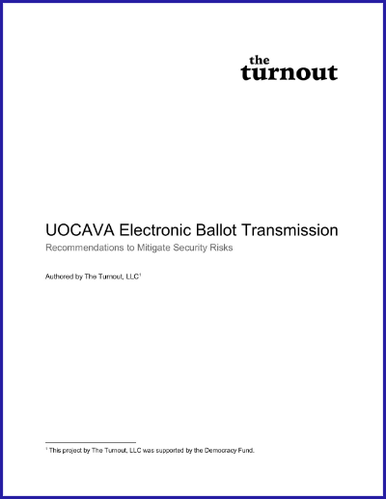The Turnout researched methods of electronic ballot return by UOCAVA voters, culminating in a set of technical recommendations for UOCAVA Electronic Ballot Return.
U.S. military and overseas voters face unique challenges. Residing in a technically-isolated area or lacking access to regular mail delivery are only two possible scenarios that would make it difficult for these voters to register to vote, receive a blank ballot, and cast a completed ballot. Election administrators strive to meet the needs of these voters in various ways, sometimes leveraging technology. In some states, legislative or policy directives have also been applied to codify these practices.

The Turnout, along with Magenta Sage Strategies and R. Michael Alvarez, PhD, researched methods of electronic ballot return by UOCAVA voters. This research culminated in a set of technical recommendations for UOCAVA Electronic Ballot Return. The document provides security recommendations for the current practices surrounding electronic blank ballot delivery and voted electronic ballot return within U.S. states and jurisdictions. These recommendations aim to be actionable for election officials, related intragovernmental agencies, and other related stakeholders. The recommendations contained here are not solely technical recommendations, as many procedural and operational safeguards are also suggested that can be implemented by election officials to help secure the election process.
These recommendations should not be considered an argument for any particular method of UOCAVA electronic ballot return, nor a blueprint for fully-securing any of these modes. In fact, the National Institute of Standards and Technology (NIST) concluded that there are unresolved computer security and voting technology issues around endpoint security (e.g. securing voter-owned and State-owned devices against attack), voter authentication, and ballot auditability for remote electronic voting. Ways and methods of securing online voting is an active field of research and there is not a clear solution at this time.
As we developed these recommendations through the lens of our individual technical backgrounds, this document is hopefully the beginning to a conversation with election officials about technical, physical, and operational security and the obstacles they face when trying to implement them at every jurisdictional level. Suggestions we may view as “simple” may be unrealistic in a small elections office. Restricting access to certain machines may be physically impossible due to space constraints. The purchase of an independent and isolated fax machine may be outside the operational budget. These issues will likely vary from jurisdiction to jurisdiction.
The Turnout, in conjunction with R. Michael Alvarez, PhD, and Magenta Sage Strategies, is deeply thankful to the Democracy Fund for their generous support of this work. They would also like to thank their colleagues who collaborated in preparing this document. John Dziurłaj and Joshua M. Franklin provided valuable content, document review, and editing assistance. Stacey Scholl, Lindsay Daniels, and Tammy Patrick of the Democracy Fund lent subject matter expertise and editorial advice. Please download the report and let us know what you think.

 Jared Marcotte
Jared Marcotte

